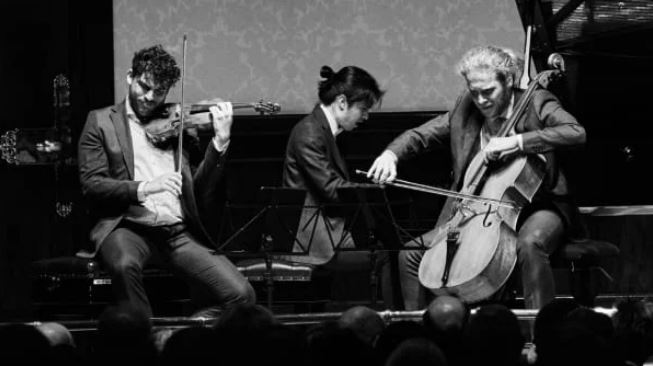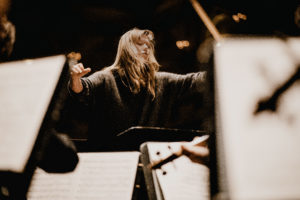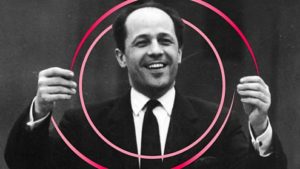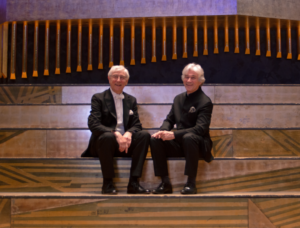
At the end of yesterday’s concert at Wigmore Hall pianist Lorenzo Nguyen said that as the concert had been “very tough” that their encore piece would be a movement from Haydn trio. This did add some welcome light relief as for the proceeding hour he and his colleagues in Trio Chagall had taken the audience on an emotional rollercoaster. Trio Chagall were playing three works that all had a relationship with their namesake, the painter Marc Chagall and his home city of Vitebsk. The programme started and ended with Dmitri Shostakovich’s First and Second Piano trios and sandwiched in between was Aaron Copland’s Vitebsk. (Look at this blog to find out more about the inspiration for Vitebsk and see parts of it being played).
The group from Turin are part of the Young Classical Artists Trust (YCAT) and are already multi award winning. I’m delighted to say that they brought their A game to a packed Wigmore Hall.
 Shostakovich’s first trio was an early work from 1923. He was 17. With its romantic leanings, it sounds nothing like the mature Shostakovich[i]. Cellist Francesco Massimino lived every emotion with his face. It was all there – agony, ecstasy, startled surprise, yearning, melancholy. There were lots of pursed lips, puffed out cheeks and wide eyes. Violinist Edoardo Grieco added a brooding intensity of a Spaghetti Western gunslinger. I’ve rarely seen such expressive players and you couldn’t take your eyes off them.
Shostakovich’s first trio was an early work from 1923. He was 17. With its romantic leanings, it sounds nothing like the mature Shostakovich[i]. Cellist Francesco Massimino lived every emotion with his face. It was all there – agony, ecstasy, startled surprise, yearning, melancholy. There were lots of pursed lips, puffed out cheeks and wide eyes. Violinist Edoardo Grieco added a brooding intensity of a Spaghetti Western gunslinger. I’ve rarely seen such expressive players and you couldn’t take your eyes off them.
If the first piece was a surprise to the Wigmore audience, I think it likely that the second one was off the charts. In a scale of 1 to 5 for accessibility, I would suggest that Copland’s Vitebsk – Study on a Jewish Theme would score about minus 1! I feel certain that based on most people’s knowledge of Copland’s music; the majority of unsuspecting Wigmore patrons would have been expecting something a little more congenial!
Copland composed Vitebsk in 1928 and based it on music that he heard in the play The Dybbuk by S. Ansty. Copland named his trio Vitebsk after an industrial town in Belarus (which was the birthplace of Ansty as well as Marc Chagall). The original play involved a ghost story and Copland set out to get across “the harshness of Jewish life in white Russia”. It achieves this. It is brutally jagged and very traumatic. I think this piece is probably the originator of what Copland later termed his “laying down the law style”. Lorenzo Nguyen really banged out the almost bruising declamatory chords. You can definitely hear some hints of the Copland work that was just around the corner – The Piano Variations.
Copland is well known for being able to paint pictures with his music of the wide open prairie and the New York skyline. And here again, he manages to create a canvas that is a stark, bleak and unrelenting depiction of the ghetto where just getting through one day to the next is an achievement. Of course, the music as written can only paint the picture that the composer intended if it is performed well. And it was!
On first encounter, you would say that this music couldn’t be more different from Copland’s later populist works such as Appalachian Spring. But wait just one moment! As different as they are it is worth listening to these compositions side by side. Both works are about the day-to-day existence of ordinary people, accepting their lot. One should remember, that despite the outward expression of purity and perfection, there is a good deal of anxiety and apprehension in Appalachian Spring (the full ballet version that is). Similarly, despite the grimness of poverty and oppression, there is laughter and dancing in the ghetto of Vitebsk. That said, in the central scherzo it comes across as gallows humour, – very dark and laced with Chagall like grotesquerie. Whilst Vitebsk conjures up images of persecution and racial injustice, in Appalachian Spring there is the fire and brimstone unleashed by the Revivalist (Fear in the Night) and later the Bride’s brief episode of mental fragility (Moment of Crisis).
For an almost direct quote of music in both works listen to the almost heavenward looking chord played by the cello and violin at the end of the middle scherzo of Vitebsk (08:15 on the Music from Copland House Recording) and the opening of the Day of Wrath section of Appalachian Spring marked Very Deliberate in the Hugh Wolf / St Paul Chamber Orchestra version. I personally think there is an uncanny resemblance. I wonder if Copland was aware of this? By design or coincidence, it does feel that in both instances, there is a deep pause for breath and a heartfelt plea for spiritual intervention.
Furthermore, both pieces have a similar end – Appalachian Spring is tranquil but strong, resilient, bold and ultimately optimistic. Vitebsk is equally quiet but hardened, embattled, uneasy and possibly prepared for the worst.
Vitebsk is an important Copland work. It was one of only a few that included Jewish references. It also paved the way towards Copland’s leaner modernist works (Piano Variations, Symphonic Ode, Short Symphony). Much is made of Copland moving on from jazz after his Piano Concerto. Vitebsk should also be considered as a huge transition work. It was the last Copland piece that portrayed ghoulish, gothic, ghostly themes and a fascination with death (found in Grohg and its offshoots Cortege Macabre and Dance Symphony as well as the Organ Symphony, the chorus The House on the Hall and the setting of ee Cummings In spite of Everything (Poet’s Song). Also, after Vitebsk, Copland hardly ever used grotesquerie in his music again. This had been almost ever present in his 1920s output in sections of the aforementioned works as well as Music for the Theatre. Going forward this type of music is only found in Hear Ye Hear Ye! (which recycles parts of Grohg) and more obliquely in the puppet show piece From Sorcery to Science.
It was the first time that I had seen Vitebsk played live and Trio Chagall did a fine job indeed. After that they needed a short break to duck off the stage and take a breather. Having already been put through the ringer, they now had to gird their loins for a further and final assault on the emotions, which if anything was even tougher.
Whereas, Shostakovich’s first piano trio was about love his second was all about the untimely death of a dear friend, the intellectual Ivan Sollertinsky (who was also from Vitebsk). I can sometimes be a bit sniffy about Shostakovich, mainly as a result of the duration of his pieces which (for me at least) often outstay their welcome. However, there is no baggage here. This is one of the things I love about going to a concert to hear Copland – being introduced to another piece that I didn’t know, that is really up there in the top drawer.
Sollertinsky died aged 41 and the loss affected Shostakovich immensely and he struggled with depression and couldn’t compose for months. You can hear all five stages of the grief process within this work: denial, anger, depression, bargaining and acceptance. It was written in 1944 and Shostakovich would have also been aware of news of Nazi atrocities and death camps. I’m used to listening to Shostakovich symphonies and reading about the alternative meanings and sub text. But here, this is Shostakovich wearing his heart very much on his sleeve.
This is some of the most poignant music I have heard. The opening cello playing and the third movement (Largo) are devastatingly sad. (For me it trumps any funeral march by Beethoven or Mahler which is saying something! The Largo also sounds like it might well have provided the inspiration for the music composed by Jeff Russo for the TV series Fargo). The second movement scherzo indicates the ebullience of a huge life snuffed out too early. In the final movement there is some levity but in the form of a dance of death. It ends as it begins and the players stayed motionless for about 20 seconds before the well earned applause.
The Haydn encore was a true balm to the spirit and showed these guys can do it all. It was a standout concert, and on this showing, I am sure that Trio Chagall will become a big draw at venues worldwide.
[i] Shostakovich’s first piano trio was originally titled Poème. By way of sheer coincidence, in 1918, when Aaron Copland was also 17, he too composed a piece for cello and piano called Poème. Both the Shostakovich trio and Copland’s Poème are great pieces of juvenilia. They might not give away too much about the music yet to come, but they do indicate a tremendous mastery of the talents that will later be fully unleashed with their own voice.









Leave a Comment